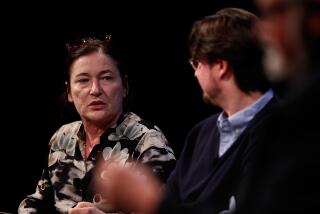‘Cringe’ offers tales of mortification -- in comics form
We’ve all been there -- shamed to the point of silence by an unintended revelation or faux pas. Not only that, but these experiences linger; I still buckle at the memory of certain situations, certain interactions, even though they have long since passed.
This interplay of mortification and memory occupies the tormented heart of “Cringe: An Anthology of Embarrassment” (Birdcage Bottom Books: 112 pp., $8 paper), which collects 25 stories by comics artists including Elijah Brubaker and Jeffrey Brown. Edited by Peter S. Conrad, it’s a bit of a mixed bag, with some pieces that seem incidental or unfinished, but at best, it lives up to its name.
In “Like a Hamster,” Sam Spina recalls repelling two women in a bar by drinking from the spout of a liquor bottle “like a hamster”; “Oh my God, that’s so embarrassing,” his fiancee tells him when he recounts the story to her.
Lizz Luna’s “Levels of Embarrassment” offers an actual chart of mortifications: Slight Shame (“Tripping Over Your Own Feet”), Blush (“Food in Your Teeth”), Flush (“Telling a Joke, Then No One Laughs”), Squirm (“Asking ‘When is the Baby Due?’ to Someone Who is Not Pregnant”) and Cringe (“Unspeakable Shame (Cannot Be Mentioned Here)”).
Many of the artists in these pages are new to me, which is one of the finest things about the book. Among the standouts: Conrad’s “Charlie’s Lovely Wife,” about a misunderstanding between two new friends, and Geoff Vasile’s “Young Girl, Get Out of My Heart,” in which a man has an encounter with a teenage runaway that leaves him haunted and unsure.
Fred Noland’s moving “Crayola 64” recalls being a grade-school misfit whose crayons are destroyed by another kid. Here, the embarrassment takes an unexpected turn when Noland imagines what might have happened to his childhood nemesis: “How hard, deprived and unhappy must his life have been,” he writes, “to want to share that misery in such a senseless and cruel way. I must have hated him at the time. Now I just feel sorry for him.”
In “The Darkroom,” meanwhile, Cara Bean looks at the experience of the misfit from a different angle, portraying an encounter at a summer arts program during which she “felt like a scruffy state school rug-rat thrown in with kids from fancy Ivy League or hip art schools.”
What Bean is describing is how it feels to be an outcast, which is as common a feeling as there is. This is the universal factor, the key point of identification, and it brings the best stories in “Cringe” to life in a way we all can recognize.
Alan King’s hilarious “Danielle” (drawn in an R.-Crumb-meets-Joe-Matt style by Jamie Vayda) is a perfect case-in-point, with its scenario, involving a drunk girlfriend and a mother’s Christmas party, that gets radically out of hand.
It’s not intention, in other words, that is the problem, but what happens in those moments of inattention when we inadvertently reveal ourselves.
Twitter: @davidulin
More to Read
Sign up for our Book Club newsletter
Get the latest news, events and more from the Los Angeles Times Book Club, and help us get L.A. reading and talking.
You may occasionally receive promotional content from the Los Angeles Times.







